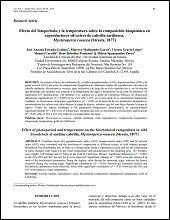Efecto del fotoperiodo y la temperatura sobre la composición bioquímica en reproductores silvestres de cabrilla sardinera, Mycteroperca rosacea (Streets, 1877)
Effect of photoperiod and temperature on the biochemical composition in wild broodstock of sardine cabrilla, Mycteroperca rosacea (Streets, 1877)
Autor
JOSE ANTONIO ESTRADA GODINEZ
MINERVA CONCEPCION MALDONADO GARCIA
VICENTE GRACIA LOPEZ
Rene Rebollar
MILTON ALEJANDRO SPANOPOULOS ZARCO
Metadatos
Mostrar el registro completo del ítemResumen
"Se estimó el factor de condición (K), el índice gonadosomático (IGS), hepatosomático (IHS) y de grasa visceral (IGV), así como la composición bioquímica en diferentes tejidos de reproductores silvestres de cabrilla sardinera, Mycteroperca rosacea, para evaluarlos a lo largo de un ciclo reproductivo y ver la relación que presentan los cambios con respecto a la temperatura del agua y fotoperiodo de la zona de muestreo. Se capturaron 187 reproductores, 146 hembras y 41 machos en el golfo de California, México. Se observaron diferencias significativas (P < 0,005) en los IGS, IHS e IGV; en el caso de K no se encontraron diferencias. También, se observaron variaciones significativas (P < 0,05) en la mayoría de los parámetros bioquímicos, encontrándose los valores más altos durante la etapa de desove, mientras que los más bajos durante la etapa de reposo. Todos los índices estimados y los parámetros bioquímicos determinados, se correlacionaron significativamente (P < 0,05) con el fotoperiodo, mientras que solo se encontraron correlaciones significativas (P < 0,05) entre el IGS e IGV con respecto a la temperatura del agua." "Condition factor (K), gonadosomatic index, (IGS), hepatosomatic index (IHS) and fat visceral index (IGV) were estimated and the biochemical composition in different tissues of wild leopard grouper broodstock was determinate too, in order to evaluate them along a reproductive cycle and see the relationship of these changes with respect to the water temperature and photoperiod in the sampling area. 187 brooders were caught, 146 females and 41 males in the Gulf of California, Mexico. Significant differences (P < 0.005) in the IGS, IHS and IGV but not for K were observed. Significant changes (P < 0.05) were also observed in most of the biochemical parameters, being the highest value during the spawning stage, whereas the lowest occurred during the resting stage. Significant correlations (P < 0.05) between all estimated indices and biochemical parameters were observed, while only significant correlations (P < 0.05) between the IGS and IGV with respect to water temperature."
Colecciones
Ítems relacionados
Mostrando ítems relacionados por Título, autor o materia.
-
PROMOCIÓN DEL PERIFITON PARA EL CULTIVO DE CAMARÓN BLANCO: HACIA UNA ACUICULTURA ECOLÓGICA
DOMENICO VOLTOLINA LOBINA; JUAN MANUEL AUDELO NARANJO; MARIA DEL ROSARIO PACHECO MARGES -
Suelo y Erosión
YOLANDA LOURDES MAYA DELGADO


